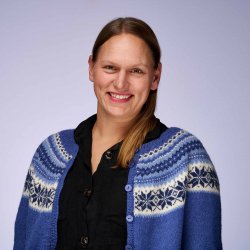The project “SmartCalfCare» aims to improve dairy cow and calf welfare through allowing them time together during the first weeks after birth. This solution may comply with behavioural needs of the cow and calf. Also, it allows for a high level of contact and transfer of milk during the first weeks-the peak in time were the cow-calf pair needs it the most. The SmartCalfCare solution may also accommodate the increased concern among consumers related to the traditional management procedure to separate cow and calf after birth. Recently, dairy farmers are also expressing needs for solutions allowing cow-calf contact for the same reasons. The SmartCalfCare project will test a pilot version of the pen-solution at the NMBU Dairy research facility. The project constitutes a cooperation between industrial partners as TINE SA, Felleskjøpet Agri, Maurstad Holding and delaval, as well as NORSØK and is led by The Norwegian Veterinary Institute and Julie Føske Johnsen.
Most dairy farms separate the calves from the dam shortly after birth. Research shows that there may be both welfare and health assets related to keeping cow and calf together. Maternal behaviours associated with caretaking of the calf, and viceversa, contact to the dam are behaviours that the cow and calf are highly motivated to perform.
Rather than allowing the calf access into the cow barn, the researchers suggest a new, flexible system for modern freestall-barns.
«SmartCalfCare» is a pen-solution composed of two smartgates (the cows- access and exit from the “smartcalfcare” pen) as well as an automatic milk and concentrate feeder. The automatic milking unit is an integrated part of the “smartcalfcare” system. In the future, the farmer may control the calf’s access through an application: The cows’ access into the pen is transmitted by the cows’ RFID eartag, allowing the cow to enter the “smartcalfcare” pen in which the calf is housed. Thus, the farmer can decide that e.g. a young calf can receive several daily “visits” of its dam during the first weeks of life, while an older calf that already eats concentrate and drinks supplemental milk, meets its dam only after evening milking. After the cow has visited and nursed its calf, the cow can leave to join the herd, feed and rest. Every calf will have individual access to concentrate and milk, to secure that they develop into functional ruminants and to accommodate a smooth separation from the dam at the age of e.g. 4-6 weeks.
«SmartCalfCare» generates data that can be used to document and to make informed decisions for each of the cow-calf pairs. The farmer receives important information on natural behaviours in the herd. The pen can be set-up in already existing barns, and is composed of technical entities already existing in many dairy farms today.
The current project is a pilot project which will answer some questions, but more importantly, new questions will arise. Relevant questions that we would like to answer are related to the technical solutions – will the smartgates work with regards to allowing cows (but not calves) to exit from the “smartcalfcare” pen? How will the “smartcalfcare” solution comply with the natural behaviours of cows and calves? How will the cows’ dairy production affected? The calves’ nutritional needs must be met- it will receive milk through suckling the dam, but also supplemental milk in addition to roughage. We also ask whether the cow at all will be motivated to visit its calf?
The project won an innovation camp on the topic of animal welfare in 2019 which resulted in a support of 400 000 kr from the Research Council of Norway. The project is co-funded industrial partners; TINE SA, delaval and NMBU`s dairy research facility and will carry on until June 2020.
Project manager
Partners
TINE, in cooperation with, Veterinærinstituttet, Felleskjøpet Agri, NORSØK, NMBU; Senter for Husdyrforsøk, Maurstad Holding and Delaval will test a pilot version of the SmartCare pen during 2019-2020.
